INDEX
- English
- 日本語
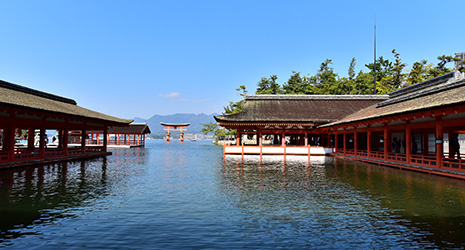
Itsukushima Shrine, an example of the shinden-zukuri style of architecture - English
- 日本語
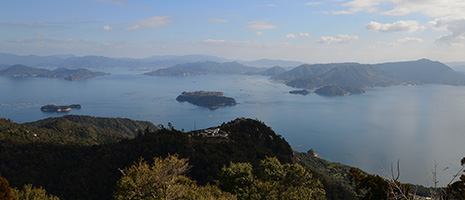
View from the summit of Mt. Misen overlooking islands in the Seto Inland Sea
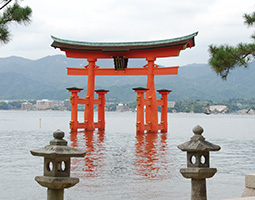
The vermilion-lacquered O-torii (Grand Torii Gate) 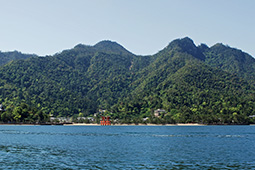
Mt. Misen 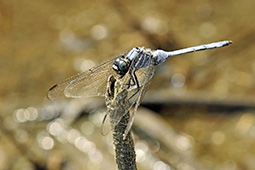
An adult male Miyajima dragonfly (Orthetrum poecilops)
November 2021
A Sacred Island where Nature Is in Harmony with Culture

Itsukushima, also known as Miyajima, lies in Hiroshima Bay in the Seto Inland Sea. The island offers a harmonious blend of history and culture centering on the Itsukushima Shrine, and nature centering on Mt. Misen, which serves as a backdrop to the shrine.

Itsukushima in Hatsukaichi City, Hiroshima Prefecture, also known as Miyajima (hereinafter Miyajima), is located in Hiroshima Bay in the Seto Inland Sea. The island has been widely regarded as one of the three most scenic spots in Japan, along with Matsushima in Miyagi Prefecture and Amanohashidate in Kyoto Prefecture. Miyajima is an oval-shaped island around 30 kilometers in circumference and has an area of 30.2 square kilometers. As of October 2021, the island is home to a population of about 1,400. The main means of transportation from mainland Honshu to Miyajima is by ferry, taking around ten minutes to travel the 1.8 kilometer route. In 1952, the entire island of Miyajima was designated as part of the Seto Inland Sea National Park, and fourteen percent of the island including Itsukushima Shrine and the primeval forests of Mt. Misen behind the shrine were registered as World Heritage sites in 1996.
“Miyajima is a special place in that the island itself has been worshipped as a deity since ancient times. Until the beginning of the thirteenth century, there was no land where people could live. Itsukushima Shrine, built on the seashore, appears to float mysteriously, and it has been worshipped by the leaders of the day as well as many others,” says Saito Naoki, Section chief of the Public Information Planning Department of the Miyajima Tourist Association.

It is said that the main building of Itsukushima Shrine was constructed in 593 by Saeki Kuramoto, a member of a powerful clan that ruled the area around the shrine. The impressive vermilion-lacquered O-torii* (Grand Torii Gate) and the main building jutting out into the sea that we see today are said to have been restored in 1168 by Taira no Kiyomori (1118–1181), who established the first samurai government. The restoration was carried out using the shinden-zukuri architectural style for aristocratic residences, said to have emerged in the tenth century. In this style of architecture, the main house (shinden) is connected to the subsidiary buildings by a corridor, and a large pond is established in front of the shinden.
Taira no Kiyomori also brought the culture of the Kyoto aristocracy to Miyajima, such as bugaku (court dances and music) and kangen (music for instrumental ensembles), which he incorporated into the shrine’s rituals.

Later, craftsmen and merchants came to live alongside the Shinto priests and Buddhist monks on the island. However, Miyajima remained a sacredly revered island and an agrarian culture did not develop. As a result, the natural environment of Miyajima is untouched to this day, and its pristine forests remain. Contrasting with the shrine and the sea in the foreground is the backdrop of Mt. Misen, covered with primeval forest extending over 160 hectares (around 5.3% of the whole island). Like Itsukushima Shrine, Mt. Misen is also registered as a World Heritage site. It takes around 20 minutes by ropeway to reach the mountain station. The island is inhabited by fauna such as deer and monkeys, and has coastal wetlands that are home to creatures such as the endemic subspecies the Miyajima dragonfly (Orthetrum poecilops). Activities have been underway to protect the Miyajima dragonfly since the 2011 registration of the wetlands under the Ramsar Convention.

“Prior to the impact of COVID-19, tourists from overseas arriving on the island by high-speed boat after visiting the Peace Memorial Park in Hiroshima City would say that Miyajima was like another world because of its quiet, nature, and peacefulness. They are amazed by the spectacle of the giant boulders spread about the peak of Mt. Misen and by the stunning 360-degree panoramic view of the many islands of the Seto Inland Sea from its summit.”
Enjoy the natural beauty of Miyajima and the Seto Inland Sea by feeling the history of Itsukushima Shrine, climbing mountains, going sea kayaking, and watching the glow of the sunset over the sea. The timeless abundant appeal of Miyajima has earned it a longstanding place in the hearts of many people.
* Since September 28, 2021, the O-torii (Grand Torii Gate) of Itsukushima Shrine has been undergoing extensive conservation and repair work. The timeline for completion has not yet been determined, but it is expected to take another one or two years.


